Speech Three Questions About the Outlook

Luci Ellis
Assistant Governor (Economic)
Address to the ABE Conference
Sydney –
- Audio 16.99MB
- Q&A Transcript
- Download 303KB
I'd like to thank the Australian Business Economists for once again giving me the opportunity to speak to you this morning. Last Friday we released our regular Statement on Monetary Policy. There is a lot in there, not all of which I can cover today. Instead I'd like to take the opportunity to talk a bit more about some selected themes in that document. In particular, I'd like to talk about some of the questions we grapple with as we consider the outlook for the domestic economy.
Before I do, let me briefly summarise our current thinking on the global and domestic economies. The global economy has been picking up since mid 2016, and seems to have improved further over the course of 2017. As we came into the new year, we and other forecasters continued to upgrade our views of the outlook for the global economy.
In Australia, our forecasts for growth are essentially unchanged from the ones we published in November. We still expect growth to pick up to around 3¼ per cent over 2018 and 2019. While our forecasts for wage growth and inflation are also unchanged, there are some positive signs that make us a bit more confident that the expected pick-up in wage growth and inflation will eventuate. Business conditions are looking more positive, employment growth has been rapid, and short-term indicators of future hiring have picked up further.
We are still a bit further behind some other advanced economies in working down the spare capacity in the economy, so it might take a bit longer for the turnaround in inflation to happen here than elsewhere. But there has been progress on this front, and we expect more progress will be made over the next few years. The current expansionary stance of monetary policy has been helpful in that regard. This progress is, however, expected to be quite gradual.
In considering this more positive outlook, forecasters nonetheless must grapple with a range of uncertainties. We talk about these in the Statement, as part of the Outlook chapter. I'd like to focus on three of these uncertainties today, which we can frame as three questions.
- How much spare capacity is there?
- How much (and how quickly) will wage growth and inflation pick up as spare capacity declines?
- How resilient will consumption growth be if income growth stays weak?
How Much Spare Capacity Is There?
As I already noted, global economic conditions strengthened further over the course of 2017. The three major advanced economies are all growing above the rate of growth of productive capacity, also known as the potential growth rate. This is clear from the large and ongoing declines in the unemployment rate. The question is how much spare capacity remains in these economies. So far, inflation hasn't picked up much, and neither has wage growth. This might normally suggest that there is still some spare capacity. As this graph shows, estimates of the ‘full employment’ rate of unemployment – the rate of unemployment below which wage growth starts to pick up – in fact suggest that the United States and Japan are already at that point, if not below it. So are some of the individual countries within the euro area (Graph 1).
This full employment rate of unemployment, or non-accelerating-inflation rate of unemployment (NAIRU), is inherently unobservable, so it has to be estimated. It can be estimated a number of ways, and there is a deal of uncertainty around those estimates. Often, they come from statistical models which treat every undershoot in the inflation (or wage growth) outcome as a sign that the NAIRU is actually lower than you previously thought.
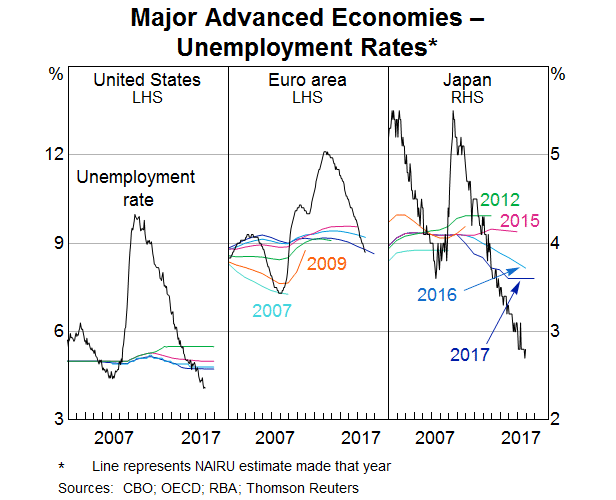
It's therefore useful to think about the economics, and the behaviour, underlying the existence of a NAIRU. It implies that there will still be some people unemployed at the point that firms have to start bidding up wage offers in order to find suitable staff. This is not so surprising when you consider that the labour market isn't homogeneous. There are so many different occupations and types of firms, and these aren't evenly distributed across the economy. So we shouldn't expect labour shortages to appear everywhere at the same time. What happens instead is that they turn up in a few pockets of the labour market, then a few more, and gradually become more widespread as conditions tighten. How quickly this happens depends partly on where the strong demand for labour is concentrated, and how much of the labour force has the applicable skills to perform those roles. So you'd expect wage growth to pick up more – and the NAIRU to seem higher – if the labour market is highly segmented and workers can't easily shift to the areas of strong demand. More flexible labour markets will, all else being equal, have lower NAIRUs.[1]
Some of the unemployment underlying the NAIRU simply reflects people who are between jobs, but will find one soon. (This is sometimes called ‘frictional’ unemployment.) How quickly people find a job in a tight labour market is partly a technological question. They need to find what vacancies are out there, work out if the job (and the firm) is a good match for their skills and interests, and then go through a selection process. How long these activities take will help determine how many people are between jobs even in a tight market. The overall rate of job turnover will also matter, because that helps determine the flow of people into job search. All of those things can change, for example because technological change makes job search or selection processes more efficient, or because transaction costs make it more expensive to move for a job.
So we shouldn't expect the NAIRU to stay at the same level forever. Rather it can shift gradually in response to structural changes in the labour market and the hiring process, among other things. But because it can't be directly observed, we can only know this from the actual behaviour of wages.
Another aspect of spare capacity that isn't always fully appreciated is the scope for extra workers to come directly from outside the labour force, or from incumbent workers working more hours, rather than from the ranks of the currently unemployed. The more that extra labour demand is met from new entrants or longer hours, the slower the unemployment rate declines. So we can think of broader notions of spare capacity than the NAIRU. These would explain why the economy might grow at seemingly above-potential rates for longer without hitting capacity constraints.
This has been a factor here in Australia, where labour force participation has increased sharply over the past year, especially for women (Graph 2). It is now very close to the historical peak it reached in 2010, during the mining investment boom. Meanwhile the unemployment rate has drifted down, but not as quickly as in some other countries. The increase in participation has been especially marked in Australia but has not been unique to us. In a number of other industrialised economies, ageing of the population might have been expected to lead to the participation rate trending down. But instead it has been flat in the euro area and is trending up in Japan, where female participation rates are also increasing noticeably. It has also stabilised recently in the US, after declining a little faster than what would have been suggested by ageing alone.
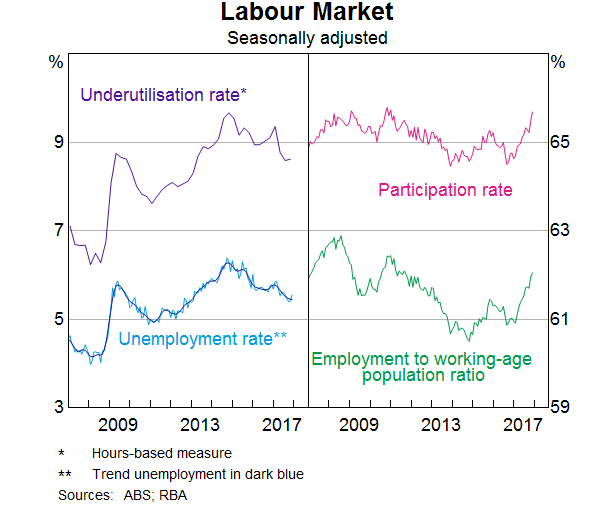
There also seems to be a cyclical phenomenon that can change the point where economies hit capacity constraints. As we saw in that earlier graph, as economies approach the NAIRU, especially if they do so gradually, the estimate of it often seems to decline. This happens on the upside as well – a prolonged period of high unemployment seems to raise estimates of the NAIRU. Some of you will know this path-dependence phenomenon by the unlovely name of ‘hysteresis’. At the current point in the global economic cycle, there is at least some chance that hysteresis will allow some of the economies with tight labour markets to grow a bit faster for a bit longer than might have previously been expected. But eventually, the point where wage growth starts to pick up is reached, and from there, inflation also increases.
In Australia, we estimate that there is still some spare capacity in the labour market. Last year we published a central estimate of the NAIRU of around 5 per cent (Cusbert 2017). Since then we have not seen a reason to change that broad assessment. But we are mindful that, as we approach that figure, there's a risk we find there is more room to come down before wage growth picks up in earnest.
How Much (and How Quickly) Will Wage Growth and Inflation Pick Up?
Whatever judgement one might make about the extent of spare capacity, it is clear that both here and overseas, it is being absorbed. As it reaches the point of being fully absorbed, wage growth and inflation should increase. The question is, how much and how quickly will they pick up? For the technically minded, this is a question about the slope of the Phillips Curve.
Here in Australia, wage growth has been quite weak even allowing for (what we estimate to be) the extent of spare capacity. Our forecasts are for wage growth to pick up from here, but not immediately and then only gradually. We are seeing some signs of labour market tightening in the business surveys, which are telling us that suitable labour is becoming increasingly difficult to find.
So far, though, the response to that difficulty has not been to pay people more to ensure they stay, or poach them from elsewhere. Instead, we hear that firms are increasingly using other creative ways to attract and keep staff without paying across-the-board wage rises. These include everything from hiring bonuses, to offering extra hours, to increasing perks and workplace conditions.
Their reasons for doing so stem from the competitive landscape, or at least how it is perceived. Even when facing strong demand and rising cost pressures, firms seem reluctant to raise their prices. This is a theme from our liaison with the business community. They appear to believe that competition is so intense that they would lose too much business if they did so. So they are especially reluctant to grant wage rises, because this would increase one of their most important costs.
We are seeing this particularly in new enterprise agreements, which lately have tended to involve smaller wage increases than the ones they replaced. These agreements usually last for a couple of years, so this will weigh on overall wage outcomes for a while. If wage growth is to pick up, wage increases for other workers – including in future enterprise agreements or in other wage-setting streams – will need to pick up.
Because of these factors, there will probably be some lag between the reports of labour shortages and a generalised pick-up in wage growth. We expect, though, that paying more will eventually become part of firms' response. Wage growth, when it comes, will tend to boost labour costs per unit of output. Despite firms' reluctance to raise prices, margins cannot be squeezed forever. Higher costs will therefore boost price inflation over time. A number of important parts of the CPI basket, including many services, have a large labour component to their input costs. These are the areas where wage pressures can be expected to show up most clearly as higher inflation.
Working against this effect, though, will be the ongoing effects of heightened competition in retail. Australia has seen a marked increase in the number of major retail players. Foreign retailers have entered the local market in recent years and continue to do so. This has also induced the existing players to reduce their costs to stay competitive, for example by improving inventory management. This has probably been a bit easier for larger or less-diversified retailers than for smaller firms. Perhaps this is one of the reasons why growth in retail sales has been much weaker for smaller firms than larger firms.
Whether through lower costs, narrower margins or a combination of both, this competitive dynamic has weighed on prices for consumer durables (Graph 3, top panel). And for staples such as food, competition and related changes in pricing strategy (such as Everyday Low Price strategies) have contributed to keeping prices barely changed in net terms for at least seven years.[2] This is clear from the bottom panel of the graph.
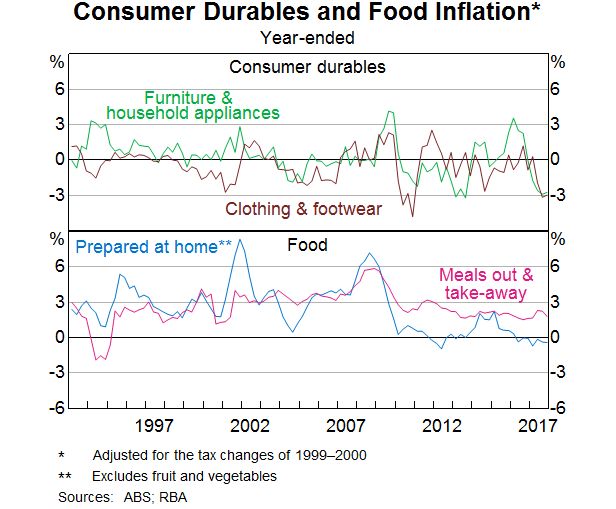
Technological change is also often thought to be holding down both wage and price inflation here and overseas. The idea that robots can take your jobs – or overseas websites take your customers – will naturally dampen anyone's enthusiasm for raising their asking prices. But an important step in the march of the robots is often forgotten: technological progress requires business investment. First, as with every wave of technology, someone has to design and make the robots. Next, businesses must invest to implement those new technologies and processes. Jobs will still get created in both stages, but they are different jobs to the ones replaced.
The issue is therefore one of distribution: whether particular countries have the skills needed to become part of that next wave of jobs, and how the income from the ensuing increase in labour productivity is shared between labour and the owners of capital. These are important questions for society, but they don't repeal the laws of supply and demand.
How Resilient Will Consumption Growth Be If Income Growth Stays Weak?
The previous two uncertainties were general to both the global economy, especially the major advanced economies, as well as Australia. We are in a different place in terms of the amount of spare capacity that remains, but the overall drivers and questions might not be that different.
One aspect of recent developments where Australia's experience differs, though, relates to household income and consumption. As we discussed in the Statement, consumption growth in the major advanced economies has been quite robust, supported by strong growth in employment. In Australia, we've also had especially strong employment growth over the past year – more than double the rate of growth in the working-age population. But that hasn't translated into strong consumption growth. Household income growth has been weak for a number of years, and that has weighed on consumption growth (Graph 4). Consumption growth hasn't slowed as much as income growth. This is what you'd expect, given that households generally try to smooth their consumption through episodes of income volatility. But there's a real question of how long that could continue if income growth stays weak. This clearly has implications for how we think about the risks to our consumption forecasts.
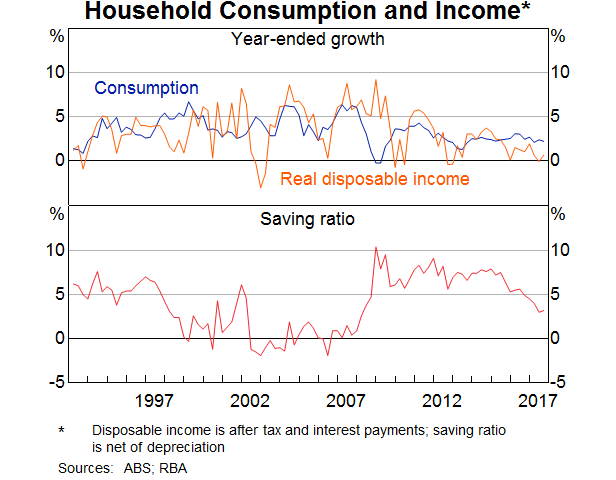
The weakness in incomes goes beyond the downward pressure on wage growth that I've already spoken about. Yes, growth in the wage price index (WPI) has stepped down. But the WPI captures a fixed pool of jobs. It abstracts from compositional change. Average earnings as measured in the national accounts have been even weaker than the WPI (Graph 5). This has not occurred because workers shifted between industries; it is also seen within industries. It might be partly driven by the end of the mining investment boom, as workers moved out of mining-related work, including in the construction and business services industries. But it seems to have been broader than that. Our central forecast is that this weakness will end as the drag from the end of the boom dissipates and spare capacity is absorbed, such that average earnings growth recovers. There is no guarantee of this, though, and therein lies the risk.
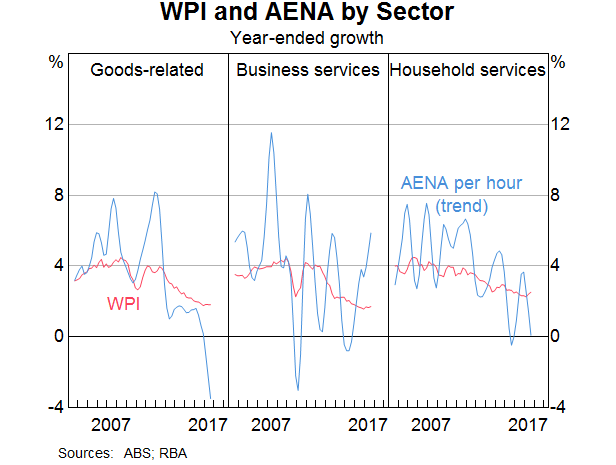
The living cost pressures that many households feel have therefore been an income story, not a price inflation story. Although utilities prices did increase significantly in some states in recent quarters, much of households' regular spending has seen relatively little in the way of price increases for a number of years.
Weak income growth can run below consumption growth for a time, but not forever. If households start to see this weakness in income growth as permanent, they are likely to change their spending patterns in response. We might be seeing this in the details of the consumption figures: growth in spending on discretionary items, like travel and eating out, has slowed while growth in spending on essentials has held up (Graph 6).
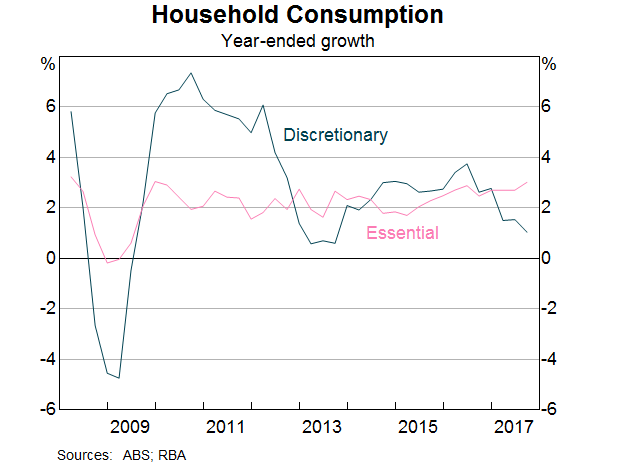
Continued weak income growth presents a particular risk to the consumption outlook in the context of high household indebtedness. Households do not just wake up one day and collectively decide to pay down their debt. But if incomes turn out weaker than they expect, or some other adverse news should arise, the households carrying the most debt might feel they have to rein in their spending quite a bit.
Concluding Remarks
The past and present are never completely clear; the future is even less so. The three questions I discussed today are not the only ones relevant to the current outlook. They are central, though, and in many ways they are connected. After a long period of spare capacity and low inflation, the global economy is now in an upswing phase. How that upswing plays out, both here and overseas, is a focus of our work. And as we do that work, we are mindful of the structural and other factors that can make a difference to economic behaviour.
Thank you for your time.
Bibliography
Cusbert T (2017), ‘Estimating the NAIRU and the Unemployment Gap’, RBA Bulletin, June, pp 13–22.